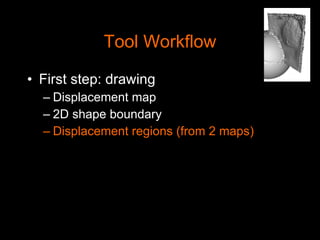Relief: A Modeling By Drawing Tool
- 1. Relief: A Modeling by Drawing Tool David Bourguignon 1 Raphaëlle Chaine 2 Marie-Paule Cani 3 George Drettakis 4 1 Princeton University / INRIA Rocquencourt 2 LIRIS / CNRS / UCBL 3 GRAVIR / INP Grenoble 4 REVES / INRIA Sophia-Antipolis
- 2. Outline Motivation Previous Work Tool Workflow Reconstruction Adaptive Sampling & Depth Inference Tool Interface Results
- 3. On Users Most people draw Writing alternative Few people sculpt Play-Doh days long gone Materials difficult to handle
- 4. Goals Use 2D tools to perform 3D operations
- 5. Goals Use 2D tools to perform 3D operations Model global and local surface
- 6. Goals Use 2D tools to perform 3D operations Model global and local surface Input: just plain strokes
- 7. Goals Use 2D tools to perform 3D operations Model global and local surface Input: just plain strokes Output: triangle mesh
- 8. Outline Motivations Previous Work Tool Workflow Reconstruction Adaptive Sampling & Depth Inference Tool Interface Results
- 9. Previous Work Depth painting [Williams, 1990] +
- 10. Previous Work Gradient editing [van Overveld, 1996]
- 11. Previous Work Maya 6.0 Artisan [Alias, 2004]
- 12. Outline Motivations Previous Work Tool Workflow Reconstruction Adaptive Sampling & Depth Inference Tool Interface Results
- 13. Tool Workflow First step: drawing input Displacement map mid-grey = 0 white > 0 black < 0 Model of 3D sphere Pencil Brush
- 14. Tool Workflow First step: drawing Displacement map 2D shape boundary (in green) defines drawing mask
- 15. Tool Workflow First step: drawing Displacement map 2D shape boundary Displacement regions (from 2 maps)
- 16. Tool Workflow Second step: modeling Displace existing vertices
- 17. Tool Workflow Second step: modeling Displace existing vertices Create new surface patch
- 18. Tool Workflow Changing viewpoint Modeling by drawing Changing viewpoint
- 19. Reconstruction Based on evolving pseudo-manifold [Chaine, 2003]
- 20. Reconstruction Based on evolving pseudo-manifold [Chaine, 2003] Satisfy our requirements Arbitrary number of connected components
- 21. Reconstruction Based on evolving pseudo-manifold [Chaine, 2003] Satisfy our requirements Arbitrary number of connected components Handle points off shape boundary
- 22. Reconstruction Based on evolving pseudo-manifold [Chaine, 2003] Satisfy our requirements Arbitrary number of connected components Handle points off shape boundary Interactive (5k points per second)
- 23. 2D reconstruction Start: pseudo-curve lies on oriented edges of Delaunay triangulation
- 24. 2D reconstruction During: pseudo-curve evolves as long as oriented Gabriel criterion is not met
- 25. 2D reconstruction Stop: topologically consistent set of oriented edges
- 26. Sampling and Depth Adaptive sampling Displacement map Pencil and brush data in color buffer Color buffer
- 27. Sampling and Depth Adaptive sampling Displacement map Approximate disp. map sampled at existing vertices
- 28. Sampling and Depth Adaptive sampling Displacement map (D) Vertex-Sampled disp. map (V) Error map E = 1 – ABS(D – V) Arbitrary error value
- 29. Sampling and Depth Adaptive sampling Displacement map Approximate disp. map Error map Sampling [Alliez, 2002]
- 30. Sampling and Depth Adaptive sampling Depth inference Identify surface vertices Vertices ID buffer
- 31. Sampling and Depth Adaptive sampling Depth inference Identify surface vertices Assign depth values Depth buffer
- 32. Sampling and Depth Adaptive sampling Depth inference Identify surface vertices Assign depth values Infer depth values from existing surface by depth propagation
- 33. Outline Motivations Previous Work Tool Workflow Reconstruction Adaptive Sampling & Depth Inference Tool Interface Results
- 34. Tool Interface Hole marks Comic books production Hole marks Stone #3 (Avalon Studios)
- 35. Tool Interface Hole marks Comic books production Our system Hole mark
- 36. Tool Interface Video: Basic interface
- 37. Tool Interface Blobbing Drawing White shading Distance field Height field Surface
- 38. Tool Interface Depth modes (chosen by menu) Modeling “at depth” Depth inference Frisket mode
- 39. Video Modeling a tree Paper sketch 3D model obtained with Relief
- 40. Outline Motivations Previous Work Tool Workflow Reconstruction Adaptive Sampling & Depth Inference Tool Interface Results
- 41. Results Models (1k to 4k points)
- 42. Discussion Intuitive shading convention
- 43. Discussion Intuitive shading convention Problems with drawing metaphor No continuous visual feedback Provide two modes
- 44. Discussion Intuitive shading convention Problems with drawing metaphor No continuous visual feedback Difficult to obtain continuous shading Provide higher-level drawing tools
- 45. Conclusion Modeling by drawing, but imprecise
- 46. Conclusion Modeling by drawing, but imprecise Future work Speedup with local 3D reconstruction
- 47. Conclusion Modeling by drawing, but imprecise Future work Speedup with local 3D reconstruction Improve depth inference
- 48. Conclusion Modeling by drawing, but imprecise Future work Speedup with local 3D reconstruction Improve depth inference Image-space and object-space sampling
- 49. Acknowledgements This work has been performed while the first author was a visiting research fellow at Princeton University, supported by an INRIA post-doctoral fellowship. Many people have indirectly contributed to it. We would like to thank: Adam Finkelstein, Szymon Rusinkiewicz, Jason Lawrence, Pierre Alliez, Mariette Yvinec, Laurence Boissieux, Laure Heïgéas, Laks Raghupathi, Olivier Cuisenaire, Bingfeng Zhou.









![Previous Work Depth painting [Williams, 1990] +](https://image.slidesharecdn.com/relief-a-modeling-by-drawing-tool-091213151515-phpapp01/85/Relief-A-Modeling-By-Drawing-Tool-9-320.jpg)
![Previous Work Gradient editing [van Overveld, 1996]](https://image.slidesharecdn.com/relief-a-modeling-by-drawing-tool-091213151515-phpapp01/85/Relief-A-Modeling-By-Drawing-Tool-10-320.jpg)
![Previous Work Maya 6.0 Artisan [Alias, 2004]](https://image.slidesharecdn.com/relief-a-modeling-by-drawing-tool-091213151515-phpapp01/85/Relief-A-Modeling-By-Drawing-Tool-11-320.jpg)







![Reconstruction Based on evolving pseudo-manifold [Chaine, 2003]](https://image.slidesharecdn.com/relief-a-modeling-by-drawing-tool-091213151515-phpapp01/85/Relief-A-Modeling-By-Drawing-Tool-19-320.jpg)
![Reconstruction Based on evolving pseudo-manifold [Chaine, 2003] Satisfy our requirements Arbitrary number of connected components](https://image.slidesharecdn.com/relief-a-modeling-by-drawing-tool-091213151515-phpapp01/85/Relief-A-Modeling-By-Drawing-Tool-20-320.jpg)
![Reconstruction Based on evolving pseudo-manifold [Chaine, 2003] Satisfy our requirements Arbitrary number of connected components Handle points off shape boundary](https://image.slidesharecdn.com/relief-a-modeling-by-drawing-tool-091213151515-phpapp01/85/Relief-A-Modeling-By-Drawing-Tool-21-320.jpg)
![Reconstruction Based on evolving pseudo-manifold [Chaine, 2003] Satisfy our requirements Arbitrary number of connected components Handle points off shape boundary Interactive (5k points per second)](https://image.slidesharecdn.com/relief-a-modeling-by-drawing-tool-091213151515-phpapp01/85/Relief-A-Modeling-By-Drawing-Tool-22-320.jpg)






![Sampling and Depth Adaptive sampling Displacement map Approximate disp. map Error map Sampling [Alliez, 2002]](https://image.slidesharecdn.com/relief-a-modeling-by-drawing-tool-091213151515-phpapp01/85/Relief-A-Modeling-By-Drawing-Tool-29-320.jpg)




















